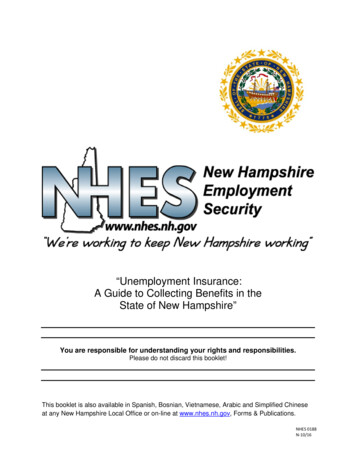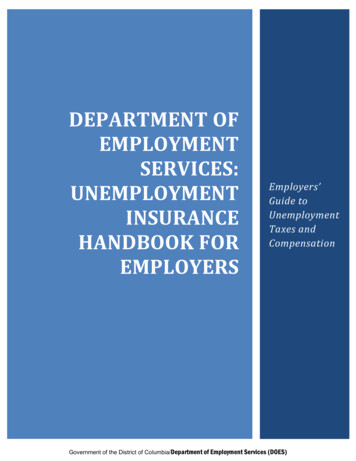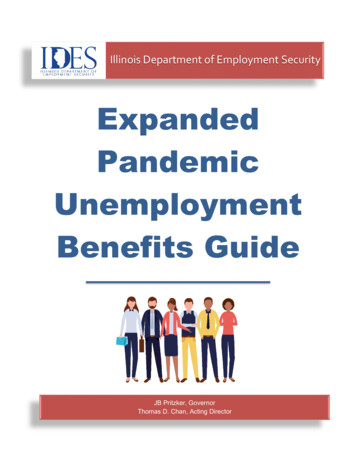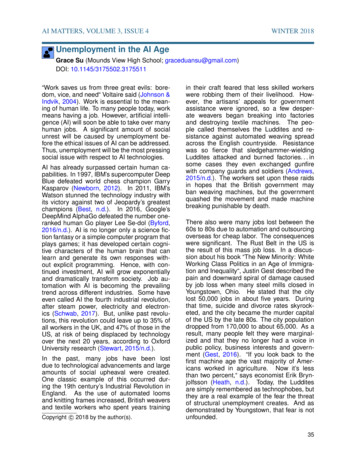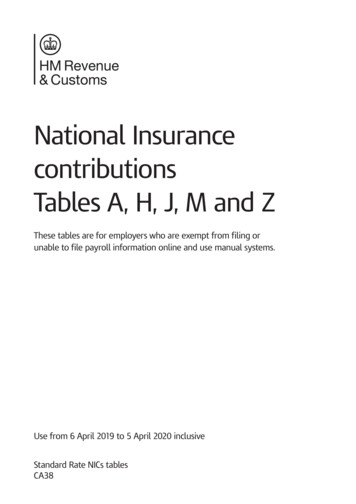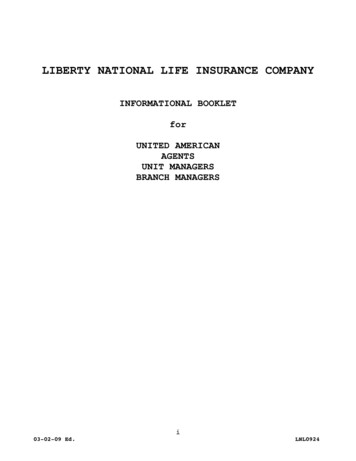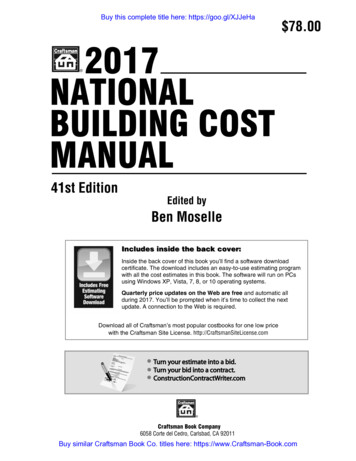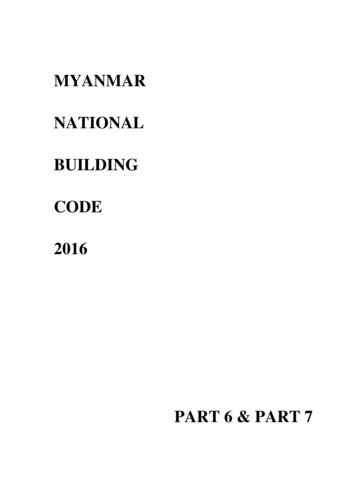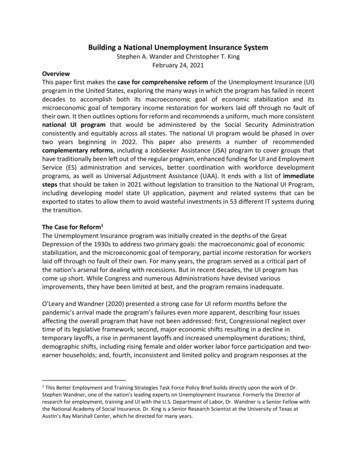
Transcription
Building a National Unemployment Insurance SystemStephen A. Wander and Christopher T. KingFebruary 24, 2021OverviewThis paper first makes the case for comprehensive reform of the Unemployment Insurance (UI)program in the United States, exploring the many ways in which the program has failed in recentdecades to accomplish both its macroeconomic goal of economic stabilization and itsmicroeconomic goal of temporary income restoration for workers laid off through no fault oftheir own. It then outlines options for reform and recommends a uniform, much more consistentnational UI program that would be administered by the Social Security Administrationconsistently and equitably across all states. The national UI program would be phased in overtwo years beginning in 2022. This paper also presents a number of recommendedcomplementary reforms, including a JobSeeker Assistance (JSA) program to cover groups thathave traditionally been left out of the regular program, enhanced funding for UI and EmploymentService (ES) administration and services, better coordination with workforce developmentprograms, as well as Universal Adjustment Assistance (UAA). It ends with a list of immediatesteps that should be taken in 2021 without legislation to transition to the National UI Program,including developing model state UI application, payment and related systems that can beexported to states to allow them to avoid wasteful investments in 53 different IT systems duringthe transition.The Case for Reform1The Unemployment Insurance program was initially created in the depths of the GreatDepression of the 1930s to address two primary goals: the macroeconomic goal of economicstabilization, and the microeconomic goal of temporary, partial income restoration for workerslaid off through no fault of their own. For many years, the program served as a critical part ofthe nation’s arsenal for dealing with recessions. But in recent decades, the UI program hascome up short. While Congress and numerous Administrations have devised variousimprovements, they have been limited at best, and the program remains inadequate.O’Leary and Wandner (2020) presented a strong case for UI reform months before thepandemic’s arrival made the program’s failures even more apparent, describing four issuesaffecting the overall program that have not been addressed: first, Congressional neglect overtime of its legislative framework; second, major economic shifts resulting in a decline intemporary layoffs, a rise in permanent layoffs and increased unemployment durations; third,demographic shifts, including rising female and older worker labor force participation and twoearner households; and, fourth, inconsistent and limited policy and program responses at the1This Better Employment and Training Strategies Task Force Policy Brief builds directly upon the work of Dr.Stephen Wandner, one of the nation’s leading experts on Unemployment Insurance. Formerly the Director ofresearch for employment, training and UI with the U.S. Department of Labor, Dr. Wandner is a Senior Fellow withthe National Academy of Social Insurance. Dr. King is a Senior Research Scientist at the University of Texas atAustin’s Ray Marshall Center, which he directed for many years.
BETS Policy Brieffederal and state level leading to declining benefit payments and tax collections to support theUI program and its administration.Key shortcomings of the current UI program include: In sharp contrast to Social Security, the taxable wage base as a percent of total wagesfor UI has declined markedly over time leading to a structural deficit in financing. Thishas put significant downward pressure on UI benefit payments and led tounderinvestment in UI and ES program administration and staffing at the federal andstate levels.As a result of declining revenues, UI wage replacement rates (i.e., the percentage ofwages replaced by UI benefits) and UI payment duration have fallen over time as well.Since 2008, UI wage replacement has fallen below 35%. These declines have been muchsharper in low-benefit states (e.g., North Carolina) than in others, reflecting employeropposition to paying taxes to support the unemployed.The percentage of unemployed workers receiving UI (the “recipiency rate”) has fallen aswell from a peak or 43% in 1938, 38% in 1979 to just over 30% recently, meaning fewerthan a third of the unemployed receive any regular UI benefits. And, in a majority ofstates, the percentage of the unemployed receiving UI were less than 25%.Disinvestment in UI and ES at the federal and state level has meant that when anunemployed worker seeks help in finding work, the reemployment services that areavailable are increasingly inadequate. Although authorized, short-time compensation orwork sharing programs, under which individuals may receive a mix of wages and UIpayments while working reduced hours, remain under-supported as well.IT systems supporting UI applications, eligibility determinations and payments havebecome seriously antiquated and inflexible in recent decades, as demonstrated by thesystems’ inability to be programmed to handle the rapid growth in claims and federalefforts to provide additional aid to those laid off as a result of the pandemic. Thosesystems also have been vulnerable to widespread hacking.UI has become far less able to timely respond to the needs of the economy and unemployedworkers, depending on drawn-out Congressional action to address economic downturns anddeclines in earnings. These and other shortcomings have resulted in a UI program that is unableto address its economic stabilization goals for the economy or to respond to the incomereplacement needs of today’s unemployed workers. The time for action is long overdue.Reforming the Regular UI Program in 2021 & Beyond: Enhancing and ExpandingThree (3) main goals for reforming the UI program are to: Pay adequate benefits to workers unemployed through no fault of their own, whiletreating states and similarly situated individuals equitably in terms of access to benefits,benefit amounts and benefit durations.2
BETS Policy Brief Provide sufficient funding to operate the program through a low uniform tax rate and aprogressive—or at least less regressive—payroll taxable wage base.Provide a comprehensive set of reemployment services to ensure that UI recipients arebetter supported in actively searching for and rapidly returning to work.Wandner (2020b) presents three main frameworks or options for substantial reform:An Enhanced Federal-State Program. States, continuing to act as partners with theUSDOL, would continue to administer the federal-state UI program while addingCongressionally-mandated federal standards that ensure uniform access and qualifyingprovisions for individuals, equal benefits, and sufficient revenue via progressive taxes.A Single, Enhanced Federal Program. State and extended benefit programs would beconsolidated into one federal program with a single set of access, benefit payment andtax provisions. States would continue to administer the federal program.A Nationalized UI Program. A national UI program, phased in over a two-year period,would be administered by the Social Security Administration and have consistent access,benefit payment and tax provisions across all states and jurisdictions.While an enhanced federal-state program and a single, enhanced federal program wouldaddress some of the current UI program’s shortcomings — e.g., increasing the consistency ofaccess, eligibility and benefits— neither would go as far as a national program in doing so. Asoutlined below, a nationalized UI program would deliver those same benefits, while alsooffering a more robust means of finance, a more timely response to economic needs, andgreater efficiency in program administration and related service provision. If this proves to be abridge too far, we recommend a single enhanced federal program that includes as many of thefollowing features as possible.Key features of the recommended National UI Program include: Administration by the Social Security Administration, including tax collection, eligibilitydetermination, benefit payment, and the provision of related services. The U.S.Department of Labor lacks experience with collecting taxes or paying benefits; the SocialSecurity Administration has well established mechanisms in place for both.Use of a simple, online UI application form supplemented by online as well as telephoneassistance from state-based staff, as needed.Improved program access and common eligibility requirements such that approximately50% of the unemployed would be able to receive UI benefits in all states.Wage replacement of 50% of lost wages up to two-thirds of the national average wage.Maximum potential payment duration of 26 weeks for all eligible unemployed workersnationally.A taxable wage base pegged directly to the Social Security wage base ( 142,800 in 2021)with an estimated tax of approximately 1.4% paid by employers (Pavosevich, 2020),resulting in a far more efficient UI program in terms of tax collection and revenuestability.3
BETS Policy Brief Elimination of employer experience rating, in which states levy UI taxes based onemployer-specific layoff rates, because of weaknesses in the current system (Miller &Pavosevich, 2019).Automatic triggers to institute extended (longer-duration) UI benefits paid from federalgeneral revenue. Emergency benefits to cover extraordinary circumstances establishedby Congress, as needed.Substantially increased funding and support for self-employment and reemploymentservices (Spiker, 2020).Much stronger federal support for short-time compensation/work sharing options(Becker & Roberts, 2020).Increased funding to support and expand current state and local ES/UI merit systemstaff, including administrative law judges and others or, alternatively, ensure theirtransfer to the Social Security Administration with full employment and seniority rights.A common UI/SSA data record based on a single set of definitions for benefit and taxsystems for terms like “employer,” “employment,” “wages” and other key items.Quarterly employment and wage reporting thus would be simplified and less costly,especially for multi-state employers, which now are required to report and pay taxes inmultiple jurisdictions.A single application, benefit payment and tax system, in which all UI data systems wouldbe centrally held and analyzed by a federally-funded research and development center(Lane, 2020).Complementary ReformsIn addition to reforming the regular federal/state UI program, we recommend severalcomplementary reforms to improve the attainment of both the macroeconomic and themicroeconomic goals of UI. First, a new JobSeeker Assistance (JSA) program would be established to provideunemployment support for new labor market entrants, reentrants, and other noncovered groups, e.g., gig economy workers, who fall outside the coverage of the regularUI program for experienced, regular wage and salary workers (West et al. 2016). Thetemporary Pandemic Unemployment Assistance effort has filled this void since March2020 but an ongoing program to address this shortcoming is needed.Second, the definition of “employed workers” would be expanded to include large andgrowing numbers of workers who are currently misclassified as independent contractorseven though their pay and the everyday details of their work are set by the businessesthey serve. A method for covering self-employed workers also would be developed.Third, funding for the ES would be increased so that staff-assisted reemploymentservices could be provided to all permanently laid off unemployed workers.Fourth, for those unemployed workers who require additional skills training to qualifyfor new jobs, the UI program needs to be much better integrated with the array ofexisting workforce training programs, as discussed further in an earlier BETS brief(McCarthy, Van Horn & Prebil, 2021). The result would be a smoother flow of4
BETS Policy Brief unemployed workers, as needed, from UI to ES and on to workforce training programs,aligning with recent recommendations made by UI program staff.Fifth, Universal Adjustment Assistance (UAA) would be provided to unemployed workerswho need income support while training for new skills, along the lines of what thecurrent Trade Adjustment Assistance program now provides, as discussed in a recentBETS brief (Good, 2021). Too many unemployed workers have been unable toparticipate in training in recent decades due to their inability to support themselves andtheir families while attending school or training programs. While evaluations have foundthat TAA’s economic costs tend to exceed its benefits (D’Amico & Schochet, 2012),providing such support is more a matter of equity than efficiency. Moreover, a majorreason for TAA’s inefficiency is the time-consuming burden – for workers andadministrators — of proving that the job loss was the result of trade or production offshoring, something that has no bearing on their prospects for reemployment. Providingassessments, counseling and provider performance information would lead to greaterprogram effectiveness (Barnow, 2009).Immediate 2021 ActionsThe reforms presented above are changes that would be accomplished over the next two yearsthrough Congressional action. Several administrative/executive and legislative actions areneeded immediately as well (Wandner, 2021).Administrative actions for consideration include: Increase staffing for the National UI office by filling vacancies and recruiting experiencedstate staff Expand UI and ES services by state UI and ES agency consultants temporarily detailed tothe national office to improve program administration and guidance Greater use of proactive advice to the state programs using UI Program Letters andproviding more technical assistance. Formally reestablish the US Employment Service, required by the Wagner-Peyser Actbut which was allowed to lapse in 2002-2003.Legislative actions for consideration include: Develop an exportable model (low-cost, flexible) state UI application, benefit payment,tax and reporting systems with dedicated funding from Congress, thereby avoidingwasteful, large-scale IT investments in 50-plus state legacy systems. For the remainder of the pandemic-induced recession and subsequent recovery, enactfederal UI programs that 1) increase the duration of UI payments, 2) continue thePandemic Unemployment Assistance program, and 3) increase the UI replacement ratebeyond 50% of lost wages. Rigorous research indicates that increased UI paymentsduring the pandemic-induced recession are not incentivizing most workers to chooseunemployment over work (Edwards, 2020).5
BETS Policy Brief Reestablish a dedicated research and evaluation budget for the Employment andTraining Administration, one that is separate and distinct from the one for the ChiefEvaluation Office of USDOL.ReferencesBarnow, Burt S. 2009. “Vouchers in U.S. Vocational Training Programs: An Overview of WhatWe have Learned.” Journal for Labour Market Research, March. .com/articles/10.1007/s12651-009-0007-9Becker, Hailey and Lily Roberts. 2020. “Improving the Work Sharing System to AbsorbEmployment Shocks.” Center for American Progress. November ystem-absorb-employment-shocks/D’Amico, Ronald and Peter Z. Schochet. 2012. The Evaluation of the Trade AdjustmentAssistance Program: A Synthesis of Major Findings. Social Policy Research Associates andMathematica Policy Research, Inc. ndingsEdwards, Kathryn Anne. 2021. “The pandemic is completely changing the way we treatunemployment.” The Washington Post. Reporting on Rand Corporation research.January 29. completely-changingthe-way-we-treat.htmlGood, Larry. 2021. Modernizing and Investing in Workforce Development. Atlanta: FederalReserve Bank of Atlanta. A Better Employment and Training Strategies Task Force PolicyBrief. February.Lane, Julie. 2020. Democratizing Our Data: A Manifesto. Cambridge, MA: The MIT Press.McCarthy, Mary Alice, Carl Van Horn and Michael Prebil. 2021. Building Back Better: A NationalJobs Strategy. Atlanta: Federal Reserve Bank of Atlanta. A Better Employment andTraining Strategies Task Force Policy Brief. February 18.Miller, Michael, and Robert Pavosevich. 2019. “Alternative Methods of Experience RatingUnemployment Insurance Employer Taxes.” Public Budgeting & Finance, tract id 3616269O'Leary, Christopher J. and Stephen A. Wandner. 2020. "An Illustrated Case for UnemploymentInsurance Reform." Upjohn Institute Working Paper 19-317. Kalamazoo, MI: W.E.Upjohn Institute for Employment Research. https://doi.org/10.17848/wp19-317.Pavosevich, Robert. 2020. “How Much Would a National Unemployment Insurance ProgramCost?” September 24.Spiker, Kathleen. 2020. “A 21st Century Reemployment Accord, National Skills t-accord/6
BETS Policy BriefWandner, Stephen A. 2020a. "Options for Unemployment Insurance Structural andAdministrative Reform: Proposals and Analysis." Policy Paper No. 2020-020. Kalamazoo,MI: W.E. Upjohn Institute for Employment Research. https://doi.org/10.17848/pol2020020.Wandner, Stephen A. 2020b. “A National Unemployment Insurance Reform Proposal.”December 10.Wandner, Stephen A. 2021. “UI Reform and Improvement: Short-term Ideas.” February 20.West, Rachel, Indivar Dutta-Gupta, Kali Grant, Melissa Boteach, Claire McKenna, and JudyConti. 2016. Strengthening Unemployment Insurance Protections in America:Modernizing Unemployment Insurance and Establishing a Jobseekers Allowance.Washington, DC: Center for American Progress. /2016/05/31134245/UI JSAreport.pdf (accessed September 29, 2017).Appendices Appendix A: Wandner 2020b paper with Pavosevich appendix Appendix B: Wandner 2021 paper on short-term UI reforms7
BETS Policy BriefA National Unemployment Insurance Reform Proposal: Appendix AStephen A. Wandner, Ph.D.12/10/20Summary and OverviewThe federal-state unemployment insurance (UI) partnership has been deteriorating for overfour decades. As a result, the UI program has not been fulfilling either of its two goals: 1)providing adequate temporary wage replacement to workers unemployed through no fault oftheir own, and 2) automatically stabilizing the U.S. economy by helping to maintainconsumption during recessionary periods. The percentage of unemployed workers who collectUI benefits has been declining, and, for those who collect benefits, the wage replacement rateand the maximum potential duration of benefits also have been declining. These overalldeclines mask the wide variation in the adequacy of UI benefits across states, with a substantialnumber of states engaging in a “race to the bottom.” Many states have severely weakenedtheir state UI benefit payment systems and have refused to fully fund the program, resulting ina decline in UI benefits available to unemployed workers as a percent of total wages (O’Learyand Wandner 2020). Today, the program desperately needs comprehensive reform.While comprehensive UI reform could make use of various alternative approaches (Wandner2020), this proposal recommends a national UI program run like the Social SecurityAdministration’s (SSA’s) old age assistance program.2 The U.S. Department of Labor’s (USDOL’s)Office of Unemployment Insurance, with its steadily declining staff – now comprising fewerthan 50 professional staff – is not able to oversee a multi-billion-dollar program operatingseparately in 5
1 This Better Employment and Training Strategies Task Force Policy Brief builds directly upon the work of Dr. Stephen Wandner, one of the nation’s leading experts on Unemployment Insurance. Formerly the Director of research for employment, training and UI with the U.S.
